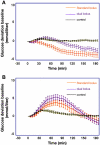Insulin pump therapy: what is the evidence for using different types of boluses for coverage of prandial insulin requirements?
- PMID: 20144405
- PMCID: PMC2787051
- DOI: 10.1177/193229680900300631
Insulin pump therapy: what is the evidence for using different types of boluses for coverage of prandial insulin requirements?
Abstract
Bolus infusion of insulin along with a meal is a standard procedure with continuous subcutaneous insulin infusion. Modern insulin pumps allow applying this bolus in four different ways: infusion of the total dose at once or splitting the dose into two boluses, infusion of a part of the bolus in the usual manner plus infusion of the other part over a prolonged period of time (with a higher infusion rate than the basal rate), or infusion of the total dose in the form of an elevated basal rate. Depending on the composition of the given meal and its glycemic index, this is an attempt to match the circulating insulin levels to the rate of glucose absorption from the gut in order to minimize postprandial glycemic excursions. However, in the framework of evidence-based medicine, the benefits of this approach should be proven in appropriately designed clinical studies. Performance of meal-related studies requires careful attention to many aspects in order to allow meaningful evaluation of a given intervention (i.e., type of bolus). Critical evaluation of the clinical experimental studies and the one clinical study published about the impact of different types of boluses on postprandial metabolic control revealed fundamental shortcomings in study design and performance in these studies. Insufficient establishment of comparable preprandial glycemia and insulinemia on the different study days within and between the patients studied is one key aspect. Therefore, the recommendation made in most of these studies (i.e., use of dual-wave bolus) has to be accepted with care, until we have better evidence.
Figures









Similar articles
-
The dual-wave bolus feature in continuous subcutaneous insulin infusion pumps controls prolonged post-prandial hyperglycaemia better than standard bolus in Type 1 diabetes.Diabetes Nutr Metab. 2004 Aug;17(4):211-6. Diabetes Nutr Metab. 2004. PMID: 15575341 Clinical Trial.
-
Benefits of a bolus calculator in pre- and postprandial glycaemic control and meal flexibility of paediatric patients using continuous subcutaneous insulin infusion (CSII).Diabet Med. 2008 Sep;25(9):1036-42. doi: 10.1111/j.1464-5491.2008.02549.x. Diabet Med. 2008. PMID: 18937673 Clinical Trial.
-
Combining basal-bolus insulin infusion for tight postprandial glucose control: an in silico evaluation in adults, children, and adolescents.J Diabetes Sci Technol. 2010 Nov 1;4(6):1424-37. doi: 10.1177/193229681000400617. J Diabetes Sci Technol. 2010. PMID: 21129338 Free PMC article.
-
Boluses in Insulin Therapy.J Diabetes Sci Technol. 2017 Jan;11(1):165-171. doi: 10.1177/1932296816653142. Epub 2016 Jul 10. J Diabetes Sci Technol. 2017. PMID: 27271845 Free PMC article. Review.
-
Impact of improving postprandial glycemic control with intensifying insulin therapy in type 2 diabetes.Postgrad Med. 2017 Nov;129(8):791-800. doi: 10.1080/00325481.2017.1389601. Epub 2017 Oct 14. Postgrad Med. 2017. PMID: 29032696 Review.
Cited by
-
Estimating insulin demand for protein-containing foods using the food insulin index.Eur J Clin Nutr. 2014 Sep;68(9):1055-9. doi: 10.1038/ejcn.2014.126. Epub 2014 Jul 9. Eur J Clin Nutr. 2014. PMID: 25005674 Clinical Trial.
-
Insulin pumps in children - a systematic review.World J Clin Pediatr. 2022 Nov 9;11(6):463-484. doi: 10.5409/wjcp.v11.i6.463. eCollection 2022 Nov 9. World J Clin Pediatr. 2022. PMID: 36439904 Free PMC article.
-
Management of diabetes mellitus: is the pump mightier than the pen?Nat Rev Endocrinol. 2012 Feb 28;8(7):425-33. doi: 10.1038/nrendo.2012.28. Nat Rev Endocrinol. 2012. PMID: 22371161 Review.
-
The impact of a pure protein load on the glucose levels in type 1 diabetes patients treated with insulin pumps.Int J Endocrinol. 2015;2015:216918. doi: 10.1155/2015/216918. Epub 2015 Feb 12. Int J Endocrinol. 2015. PMID: 25767510 Free PMC article.
-
Insulin pump risks and benefits: a clinical appraisal of pump safety standards, adverse event reporting and research needs. A joint statement of the European Association for the Study of Diabetes and the American Diabetes Association Diabetes Technology Working Group.Diabetologia. 2015 May;58(5):862-70. doi: 10.1007/s00125-015-3513-z. Epub 2015 Mar 18. Diabetologia. 2015. PMID: 25784563
References
-
- Jankovec Z, Kusova H, Cechurova D, Krcma M, Lacigova S, Visek M, Zourek M, Rusavy Z. Prague: 2008. Frequency of available insulin pump functions use by patients with diabetes mellitus. 1st ATTD Congress (Advanced Technologies and Treatments for Diabetes)
-
- Horowitz M, Wishart JM, Jones KL, Hebbard GS. Gastric emptying in diabetes: an overview. Diabet Med. 1996;13:S16–S22. (9 Suppl 5) - PubMed
-
- Rave K, Klein O, Frick AD, Becker RH. Advantage of premeal-injected insulin glulisine compared with regular human insulin in subjects with type 1 diabetes. Diabetes Care. 2006;29(8):1812–1817. - PubMed
-
- Hanas SR, Carlsson S, Frid A, Ludvigsson J. Unchanged insulin absorption after 4 days' use of subcutaneous indwelling catheters for insulin injections. Diabetes Care. 1997;20(4):487–490. - PubMed
Publication types
MeSH terms
Substances
LinkOut - more resources
Full Text Sources
Other Literature Sources
Medical

